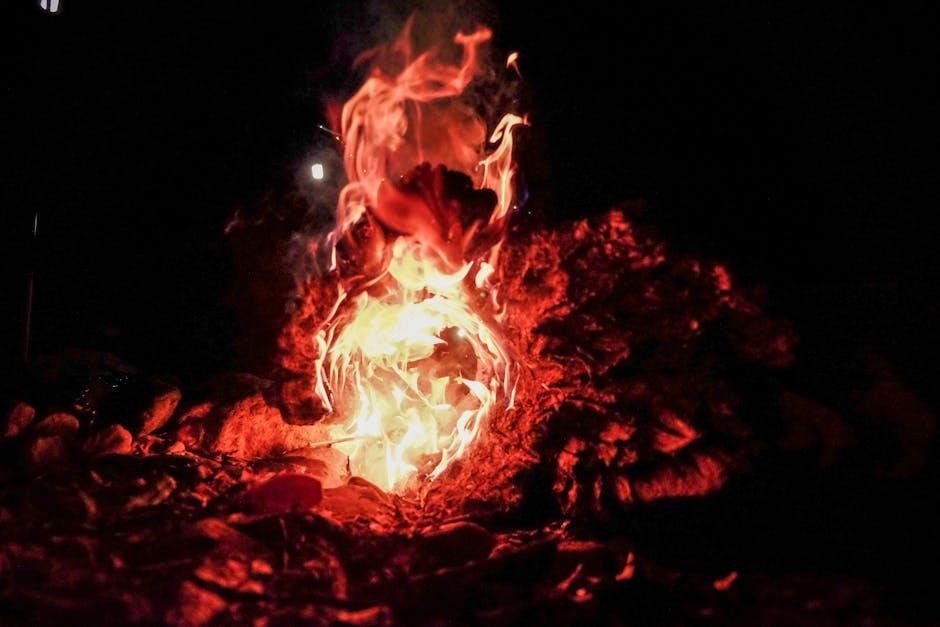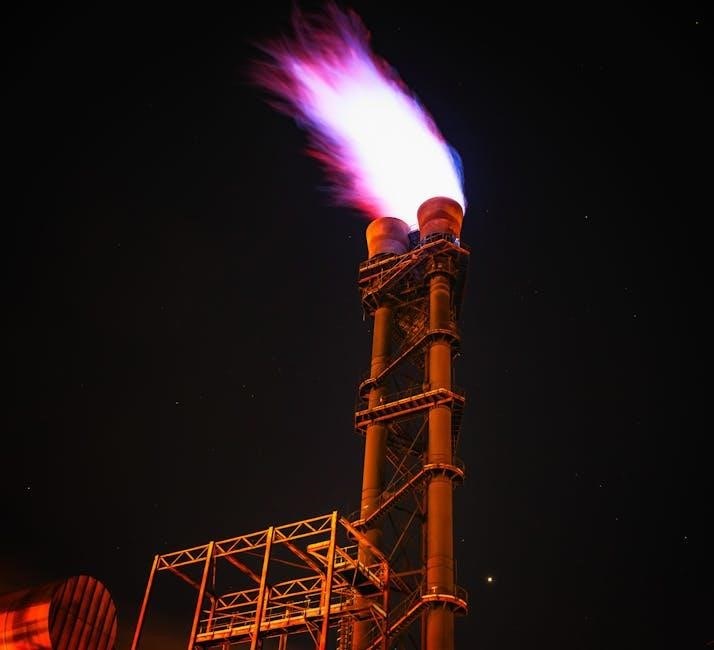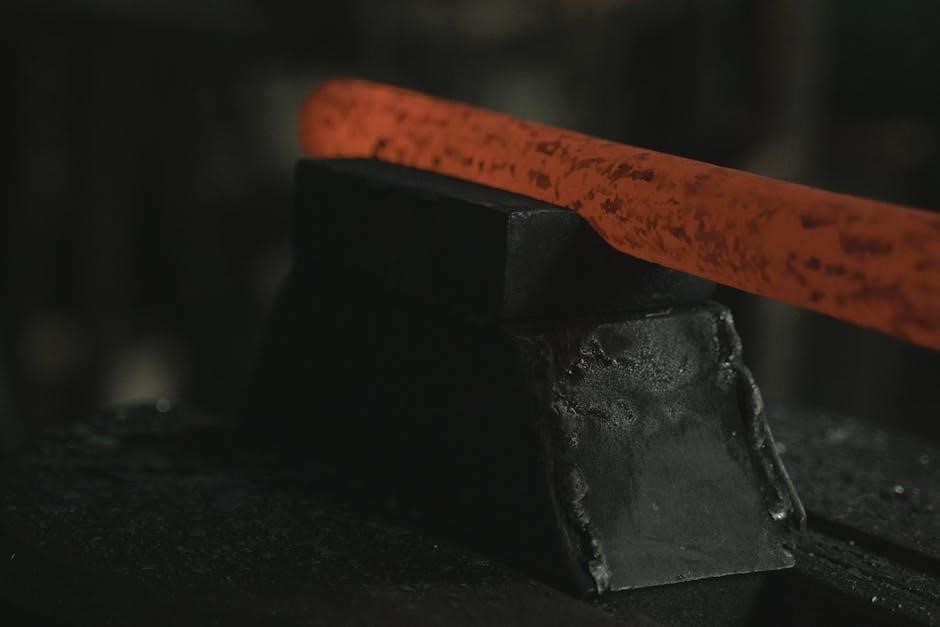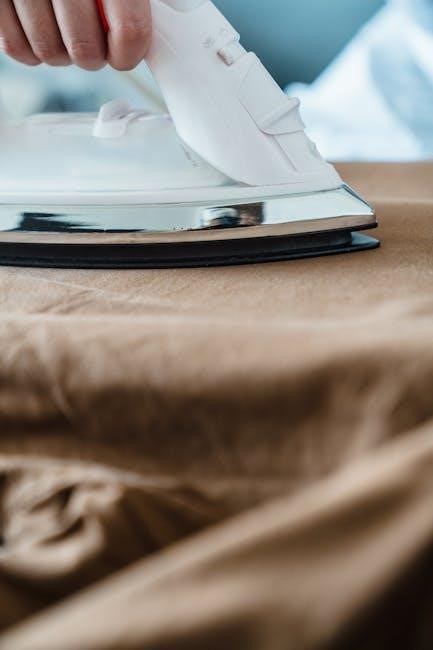The VEVOR Heat Press Temperature Guide provides essential insights for achieving professional-quality transfers․ It covers optimal temperature settings, material-specific guidance, and best practices for consistent results․
Overview of the VEVOR Heat Press
The VEVOR Heat Press is a reliable and versatile tool designed for high-quality heat transfer projects․ Known for its consistent temperature control and user-friendly design, it is a solid addition to any workshop or craft space․ The press offers automatic operation, making it efficient for both beginners and professionals․ Its durable construction ensures long-lasting performance, while interchangeable platens allow for flexibility in handling various materials․ Whether for fabric, sublimation, or specialty projects, the VEVOR Heat Press delivers professional results with ease․ Its robust features and intuitive controls make it a favorite among crafters and businesses alike, ensuring precise and consistent transfers every time․
Importance of Temperature Control in Heat Pressing

Temperature control is crucial for achieving optimal results in heat pressing․ Proper heat settings ensure vibrant colors, durable transfers, and prevent material damage․ Incorrect temperatures can lead to faded designs, scorched fabrics, or failed transfers․ The VEVOR Heat Press offers precise temperature control, allowing users to adjust settings based on material type․ For instance, cotton requires lower temperatures, while sublimation demands higher heat․ Maintaining the right temperature ensures even ink adhesion and prevents overheating, which can degrade materials․ This precision is essential for both fabric and sublimation projects, making temperature control a cornerstone of successful heat pressing․ It ensures professional-quality outcomes and extends the lifespan of your materials and press․
Understanding VEVOR Heat Press Temperature Settings
The VEVOR Heat Press offers precise temperature control, typically ranging from 260°F to 400°F․ Adjusting settings ensures optimal results for various materials, from fabrics to sublimation projects․
Basic Temperature Ranges for Common Materials
For cotton and fabric blends, temperatures typically range between 300°F to 320°F; Polyester and synthetic fabrics often require higher settings, around 320°F to 340°F․ Sublimation paper and ink need even higher temperatures, usually between 360°F to 400°F․ Leather and specialty materials like nylon may require lower temperatures, around 250°F to 300°F, to prevent damage․ Pressure settings should be adjusted accordingly, ensuring neither too tight nor too loose․ These ranges serve as a starting point, but specific projects may require fine-tuning based on material thickness and desired results․ Always refer to the VEVOR Heat Press guidelines for precise calibration to achieve professional-quality transfers consistently․

How to Adjust Temperature for Specific Projects

Adjusting the temperature on your VEVOR Heat Press depends on the material and project requirements․ For cotton fabrics, start at 300°F to 320°F, while polyester may need 320°F to 340°F․ Sublimation projects often require higher temperatures, between 360°F to 400°F․ Always consider the material’s thickness and sensitivity․ If unsure, test a small sample at a lower temperature and gradually increase as needed․ Monitoring the pressing results helps fine-tune settings for optimal outcomes․ Adjusting pressure and time alongside temperature ensures a perfect transfer․ Refer to the VEVOR Heat Press guidelines for specific material recommendations to achieve consistent, professional-quality results․

Material-Specific Temperature Guidelines
Optimal heat press temperatures vary by material: cotton (300-320°F), polyester (320-340°F), and sublimation (360-400°F)․ Adjust settings based on material type for best results․
Cotton and Fabric Blends
Cotton and fabric blends require precise temperature control for optimal results․ The ideal temperature range for cotton is between 260°F and 315°F, depending on the fabric thickness and desired finish․ For lighter fabrics, start at 260°F, while heavier blends may need up to 300°F․ Pressing time typically ranges from 10 to 15 seconds, with medium pressure applied evenly․ Ensure the fabric is preheated to remove moisture, as this enhances dye transfer and prevents scorching․ Always test a small sample first to avoid overheating, which can damage the material or cause discoloration․ Adjusting the temperature slightly higher for blends with synthetic fibers can improve adhesion and durability of the design․

Polyester and Synthetic Fabrics
Polyester and synthetic fabrics require higher temperatures for optimal heat pressing results․ The recommended temperature range is between 300°F and 320°F, with a pressing time of 15 to 20 seconds․ Medium to high pressure is essential to ensure proper adhesion of the design․ Preheating the fabric is crucial to remove moisture, which can interfere with the transfer process․ For darker synthetic fabrics, slightly increasing the temperature by 5-10°F may improve results․ However, avoid overheating, as this can cause damage or discoloration․ Always test a small sample first to ensure the settings are suitable for the specific fabric blend․ Adjusting the temperature and time based on the fabric’s thickness and synthetic content will yield the best outcomes․
Sublimation Paper and Ink
For sublimation paper and ink, precise temperature and time settings are crucial․ The recommended temperature range is between 360°F and 400°F, with a pressing time of 60 to 90 seconds․ Medium to high pressure is essential to ensure vibrant and durable transfers․ Preheating the material before pressing is highly recommended to remove any moisture, which can affect the sublimation process․ Using a Teflon sheet or heat-resistant paper is also advised to prevent ink from sticking to the press․ Always test a small sample first to ensure the settings are optimal for the specific sublimation paper and ink being used․ Adjustments may be needed based on the material’s thickness and the desired color intensity․
Specialty Materials (Leather, Nylon, etc․)
When working with specialty materials like leather or nylon, specific temperature and pressure settings are necessary to avoid damage․ For leather, a temperature range of 260°F to 315°F is recommended, with medium pressure and a pressing time of 20 to 40 seconds․ Nylon typically requires slightly lower temperatures, around 250°F to 300°F, with similar pressure and time settings․ It’s crucial to avoid overheating, as these materials can easily burn or warp․ Always use a heat-resistant sheet to protect the press and the material․ Preheating the material for a few seconds before pressing can also improve results․ Experiment with small samples to find the ideal settings for your specific project․
Pressure and Its Role in Heat Pressing
Pressure is crucial for even heat transfer․ The VEVOR Heat Press allows adjustable pressure settings, ensuring proper material contact․ Medium pressure is often ideal for most projects․
Understanding Pressure Settings on the VEVOR Heat Press
Pressure plays a vital role in heat pressing, ensuring even heat distribution and proper material contact․ The VEVOR Heat Press features adjustable pressure settings, allowing users to customize based on material thickness and type․ Medium pressure is generally recommended for most projects, as it balances quality and safety․ Excessive pressure can damage delicate materials, while too little may result in incomplete transfers․ The machine’s pressure adjustment mechanism is designed for precise control, enabling users to fine-tune settings for optimal results․ Proper pressure ensures vibrant, long-lasting designs, making it a key factor in achieving professional-grade transfers with the VEVOR Heat Press․
How Pressure Affects Transfer Quality
Pressure significantly impacts the quality of heat transfers, influencing design clarity and durability․ Proper pressure ensures even heat distribution, preventing uneven transfers or ink bleeding․ Insufficient pressure may result in faint or incomplete designs, while excessive pressure can damage materials or cause colors to fade․ Achieving the right balance is crucial for vibrant, long-lasting results․ The VEVOR Heat Press allows precise pressure adjustment, enabling users to tailor settings to specific materials․ This feature ensures optimal transfer quality, whether working with delicate fabrics or sturdy substrates․ By understanding and adjusting pressure effectively, users can achieve professional-grade transfers with ease and consistency․
Time Settings for Optimal Results
Accurate time settings ensure vibrant, durable transfers․ Recommended ranges vary from 30 to 300 seconds, depending on material thickness and type․ Precise timing enhances print quality and longevity․
Recommended Time Ranges for Different Materials
For optimal results, time settings vary based on material type and thickness․ Cotton fabrics typically require 60-90 seconds at 300-350°F, while polyester needs 90-120 seconds at 350-400°F․ Sublimation transfers often demand higher temperatures (360-400°F) for 60-90 seconds․ Specialty materials like leather or nylon may need shorter times, around 30-60 seconds, to prevent damage․ Thicker materials or multi-layered designs might require extended pressing times, up to 180 seconds․ Always refer to the specific material guidelines to ensure proper adhesion and durability․ Adjusting time based on material thickness and layers ensures a professional finish without compromising quality or integrity․
How to Determine the Ideal Pressing Time
Determining the ideal pressing time involves considering material type, thickness, and design complexity․ Start with standard time ranges: 60-90 seconds for cotton, 90-120 seconds for polyester, and 60-90 seconds for sublimation․ Thicker materials or layered designs may require up to 180 seconds․ Monitor the press’s temperature consistency to avoid under or over-pressing․ Test with scrap material if unsure, adjusting time in 15-second increments․ Always consult the VEVOR Heat Press guide for specific recommendations․ Proper pressing time ensures vibrant, durable transfers without damaging the material․ Experimentation and experience will refine your timing for consistent, professional results․

The Heat Pressing Process
The heat pressing process involves preparing materials, placing designs accurately, and executing the press with precise temperature and time settings for optimal results․
Preparing Your Material for Pressing
Preparing your material is crucial for successful heat pressing․ Ensure fabrics are clean and dry to prevent moisture interference․ Preheat the VEVOR Heat Press to the recommended temperature for your material, typically between 260°F for delicate fabrics and 390°F for heavier ones․ For cotton and polyester blends, preheating at 300-350°F is ideal․ Smooth out wrinkles to achieve even pressure distribution․ Use a heat-resistant surface or parchment paper to protect materials from direct heat․ For sublimation, ensure the substrate is compatible and free of dust․ Always refer to the VEVOR Heat Press Temperature Guide for specific settings based on material type․ Proper preparation ensures vibrant, long-lasting transfers and prevents damage to your press or materials․
Placing the Design Correctly
Proper placement of the design is vital for achieving precise and professional results․ Ensure the design is centered on the material, aligning it with the heat press’s heating plate․ Use a ruler or measuring tape to confirm the design’s position, especially for intricate patterns․ Smooth out any air bubbles or wrinkles in the transfer paper to ensure even contact․ For fabrics like cotton and polyester blends, place the design face down on the material, ensuring it is mirrored if necessary․ Proper alignment prevents misprints and ensures the design adheres evenly․ Always double-check the placement before closing the press to avoid costly mistakes and achieve the best possible outcome․
Executing the Pressing Technique
Once the material and design are properly aligned, preheat the VEVOR Heat Press to the recommended temperature for your specific project․ Carefully place the material onto the press, ensuring it lies flat and smooth․ Close the press firmly but avoid over-tightening, as this can damage the machine or the material․ Start the timer according to the guidelines for your material type, such as 60 seconds for cotton or 300-400 degrees for sublimation․ Monitor the press to ensure consistent temperature and pressure․ After the timer goes off, allow the material to cool slightly before handling․ For best results, use heat-resistant tape to secure the material in place and ensure the pressing surface is clean and dry․ Proper execution ensures a crisp, professional finish every time․

Safety Tips and Precautions
Always wear protective gloves and eyewear when operating the VEVOR Heat Press․ Ensure the workspace is well-ventilated and free from flammable materials․ Avoid overheating, as it can damage both the press and materials․ Keep children and pets away during operation․ Regularly clean and maintain the press to prevent dust buildup․ Never leave the machine unattended while in use․ Follow the manufacturer’s guidelines for temperature and pressure settings to avoid accidents․ Proper safety measures ensure a safe and efficient heat pressing experience․
Essential Safety Measures When Using the VEVOR Heat Press
Safety is paramount when operating the VEVOR Heat Press․ Always wear protective gloves and eyewear to prevent burns and injuries․ Ensure the workspace is clear of clutter and flammable materials․ Keep the press on a stable, heat-resistant surface․ Maintain proper ventilation to avoid inhaling fumes from materials like sublimation ink or vinyl․ Never leave the machine unattended while in operation․ Avoid touching the heating plate or press surface, as they can reach extremely high temperatures․ Regularly inspect the press for damage or wear and tear․ Follow the manufacturer’s guidelines for temperature and pressure settings to prevent overheating or mechanical failure․ Keep children and pets away from the press at all times․ Always unplug the machine when not in use or during maintenance․ Proper safety practices ensure a secure and efficient heat pressing experience․
How to Avoid Common Mistakes
To ensure successful heat pressing, avoid common mistakes by adhering to best practices․ Always refer to the VEVOR Heat Press Temperature Guide for specific material settings․ Incorrect temperature or pressure can damage materials or ruin transfers․ Overlooking pre-press preparation, such as cleaning the press and ensuring the surface is dry, can lead to poor adhesion․ Never skip the cooling phase, as this allows the transfer to set properly․ Avoid using excessive pressure, which can warp the press or cause uneven transfers․ Keep the press clean and free from residue to prevent contamination․ Testing settings on scrap material before final application is highly recommended․ By following these guidelines, you can minimize errors and achieve consistent, professional results with your VEVOR Heat Press․

Sublimation Printing with the VEVOR Heat Press
Sublimation printing requires precise temperature and time control․ The VEVOR Heat Press excels at handling sublimation transfers with consistent heat distribution, ensuring vibrant, long-lasting designs on compatible materials․
Temperature and Time Requirements for Sublimation
For sublimation printing with the VEVOR Heat Press, a temperature range of 360°F to 400°F is typically recommended, depending on the material․ Polyester fabrics generally require higher temperatures, around 380°F to 400°F, while other substrates may need slightly lower settings․ The pressing time usually ranges from 60 to 90 seconds, but this can vary based on the complexity of the design and the thickness of the material․ It’s crucial to maintain consistent pressure to ensure even heat distribution․ Always refer to the specific sublimation ink and paper instructions for precise settings․ Testing on scrap material first is advised to achieve the best results and avoid wasted resources․
Best Practices for Sublimation Printing
For optimal sublimation printing results with the VEVOR Heat Press, ensure the press is preheated to the recommended temperature (360°F–400°F) before starting․ Use high-quality sublimation ink and paper designed for your specific material․ Always pre-press the substrate to remove moisture and wrinkles, which can affect transfer quality․ Apply consistent, even pressure to ensure proper ink adhesion․ Allow the material to cool slightly before handling to prevent ghosting․ Test settings on scrap material first to avoid wasted resources․ Clean the press regularly to maintain performance and prevent ink residue buildup․ Following these best practices ensures vibrant, long-lasting sublimation prints with minimal effort and waste․

Troubleshooting Common Issues
Check temperature accuracy, adjust pressure evenly, and clean the press regularly․ Ensure proper material preparation and ink compatibility to avoid uneven transfers or residue buildup․
Identifying and Solving Temperature-Related Problems
Temperature issues can lead to poor transfer quality or material damage․ If prints are too light, the heat press may be underheating․ Conversely, scorching indicates overheating․ Calibrate the temperature sensor regularly to ensure accuracy․ Use a laser thermometer to verify actual plate temperature․ Adjust settings based on material thickness and type․ For sublimation, temperatures between 360-400°F are ideal․ Always preheat the press and allow it to stabilize before use․ Refer to the VEVOR Heat Press manual for specific calibration steps․ Proper temperature control ensures vibrant, durable designs and extends the lifespan of your press․
Adjusting Settings for Consistent Results
Consistency in heat pressing requires precise temperature, pressure, and time adjustments․ Start by setting the temperature based on the material—cotton typically needs 300-350°F, while polyester requires 260-300°F․ For sublimation, aim for 360-400°F․ Use the VEVOR Heat Press’s digital controller to fine-tune settings․ Ensure the press is preheated and stabilized before use․ Pressure should be firm but not excessive, avoiding damage to materials․ Adjust time based on thickness and sensitivity—cotton usually needs 10-15 seconds, while sublimation may require 60-90 seconds․ Calibrate the press regularly and use a thermometer to verify accuracy․ Small adjustments can make a significant difference in achieving professional-quality results consistently․
Mastering the VEVOR Heat Press requires understanding optimal temperature, pressure, and time settings․ Follow this guide to unlock its full potential and achieve consistent, professional results effortlessly․
Final Tips for Mastering the VEVOR Heat Press
To master the VEVOR Heat Press, always start with the recommended temperature and time settings for your material․ Experiment with small adjustments to optimize results․ Keep the press clean and well-maintained to ensure consistent performance․ Practice on scrap material before working on final projects to avoid wasted resources․ Pay attention to pressure settings, as improper pressure can damage materials or ruin transfers․ Finally, stay patient and observant, as subtle changes in temperature or time can significantly impact outcomes․ By following these tips and continuously refining your technique, you’ll achieve professional-quality results with ease․
Continuous Learning and Experimentation
Continuous learning and experimentation are key to mastering the VEVOR Heat Press․ Stay updated on new materials, techniques, and technologies to expand your creative possibilities․ Experiment with different temperature, pressure, and time settings to discover optimal combinations for unique projects․ Keep a journal to track successful settings and outcomes, allowing you to refine your approach over time․ Don’t hesitate to explore beyond standard guidelines—innovation often arises from trial and error․ By embracing a mindset of lifelong learning, you’ll unlock the full potential of your VEVOR Heat Press and achieve exceptional results in your heat pressing endeavors․
